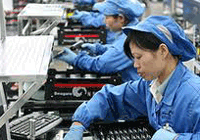
China industrial output lowest in 3 years
Beijing, May 11, 2012
Chinese industrial production weakened sharply in April as investment slowed to its lowest level in nearly a decade, showing an economy that is surprisingly vulnerable to a global slowdown and a credit crunch at home.
Industrial production rose by 9.3 percent in April, the lowest level since May 2009, while retail sales surprised the market by slowing to a 14.1 percent rise, the lowest level in 14 months.
Fixed asset investment rose by 20.2 in the first four months of the year, the slowest level since December 2002.
"It's obviously much weaker than anyone had expected. 9.3 percent for manufacturing is very telling and it shows that the economy is decelerating at a faster rate," said Ken Peng, economist at BNP Paribas in Beijing.
"All that points to the fact that domestic demand is weak and it requires more policy help."
Annual consumer inflation moderated to 3.4 percent in April from 3.6 percent in March, while food prices - which are of most concern for China's people and policymakers - rose by 7 percent, compared with 7.5 percent in March.
Easing inflation potentially gives Beijing more scope to loosen policy to help the economy rebound from a first-quarter slowdown in growth. Disappointing trade numbers on Thursday heightened jitters about a slowdown in the global economy.
"This confirms that inflation is trending down and that the policy focus will remain on promoting growth," Zhang Zhiwei, China economist at Nomura in Hong Kong. "The weak export data yesterday put more pressure on the government. This really doesn't change the market outlook on inflation that much, but probably policy loosening will become more likely going forward."
China's inflation has fallen steadily from a three-year peak of 6.5 percent in July 2011 in response to a series of policy tightening steps and weakening economic activity. Pork prices in particular have moderated, after inflation levels of over 50 percent last summer. Non-food inflation cooled to 1.7 percent.
Slowing growth has weighed on demand from China's manufacturing sector, which struggles with overcapacity in many sectors. April's Producer Price Index (PPI) dropped by 0.7 percent after a 0.3 percent drop in March, overshooting expectations.
Retreating inflation has led investors to speculate that China may cut further the amount of cash it requires banks to hold as reserves to encourage them to lend more to cash-strapped firms.
China has cut the required reserve ratio by 100 basis points from a record high of 21.5 percent in two steps, the last a 50 bp cut in February. The market consensus is for 150 bps of more RRR cuts this year, according to the benchmark Reuters poll.
Trade data on Thursday highlighted the risks to China's factory-focused economy of a fresh downturn in demand, with annual export growth of just 4.9 percent in April, below a forecast of 8.5 percent, while headline import growth stalled.
Continued softness in domestic demand is exacerbated by the impact of financial turmoil in Europe, a major export market. High domestic stockpiles of metals and iron ore made it unprofitable to import more, helping explain a mere 0.3 percent rise in China's imports in April, far short of the 11 percent growth that had been forecast.
Other than pockets of government spending, overall investment is relatively soft, weighing on demand for steel for construction as well as household appliance purchases, said steel analyst Zhou Xizheng of CITIC Securities in Beijing. "It's mostly because consumer confidence is weak," he said.
"Investment is weak because no-one wants to take on more debt." - Reuters







